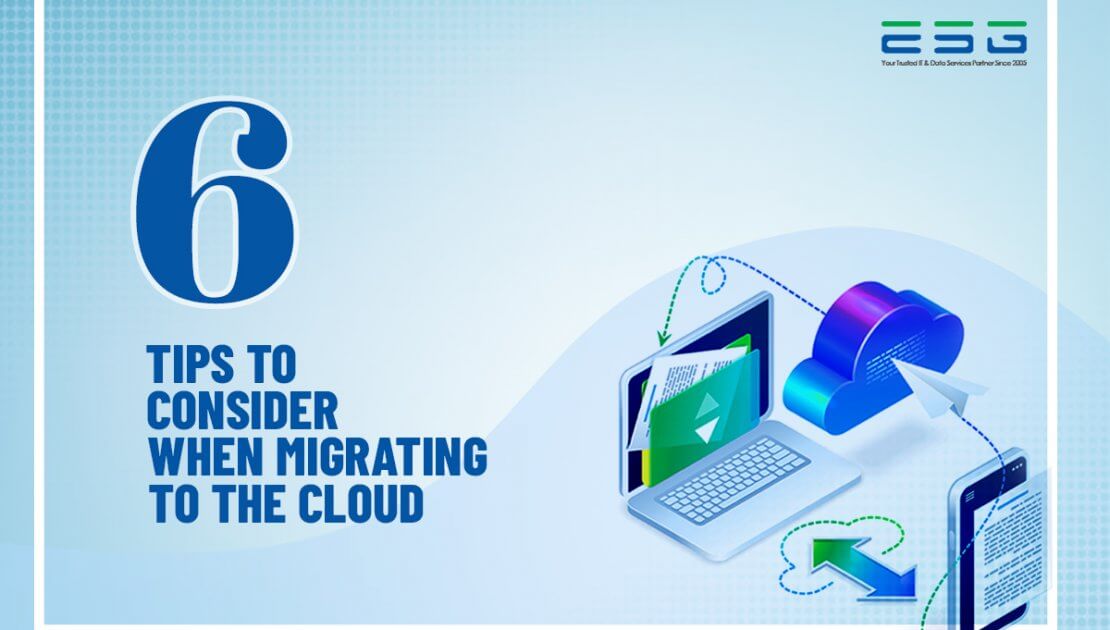94% of all enterprises use cloud computing in one form or another. There will be about 100 zettabytes of data kept on the cloud by 2025. But, migrating from a local network to a Cloud migration platform can be a daunting task. You can never be too assured about security and privacy.
Apart from cost-efficiency, (Cloud migration) offers flexibility, scalability, and productivity in day-to-day operations. We have developed 6 Cloud migration tips and tactics that ensure that your move to a cloud is safe and secure.
6 tips to consider for a successful cloud migration
- December 6, 2021
- Posted by: Subendhu Nayak
- Category: Information technology

1. Consider the current environment when making a cloud migration
Before you start even considering your move to the best Cloud migration platform, it is imperative that you assess the requirements, issues and complexities of your application, operation and program architecture. Any plan that isn’t based on how your current environment will behave post-migration will only lead to critical problems later. Hence, it is wise to build a robust and comprehensive cloud migration strategy from the get-go. Within the plan, everything right from the cloud deployment model selected to the workload division should be mentioned in detail.
2. Decide on the Cloud migration services
There are essentially four types of top cloud migration services that come across when making a selection – public, private, hybrid, and multi-cloud. Each and every one of these shares scalable computing resources across a diverse network. But, what makes them categorically different is the location and ownership.
Public Cloud migration
• Not owned by the end-user
• Mostly ran off-premises
• Partitioned and distributed between multiple tenants
Private Cloud migration
• Belongs to a single group or user
• Can be either managed (third-party) or dedicated (on-site)
• Isolated access with maximum privacy
Hybrid Cloud migration
• Single environment with multiple networks and clouds
• Apps can move in and out of the connected yet separated environments
• Consolidated resources allow scale on demand
Multiclouds Cloud migration
• More than one cloud service is taken from more than one vendor
• Inclusive of hybrid clouds when connected with some type of integration
• Serve to improve privacy, security, and disaster recovery
3. Assess the five types of risk when considering cloud migration
When setting up a new cloud, the project’s architects must assess the risks of the migration. These can be divided into five categories – agility, availability, security, supplier, and compliance. A SWOT (Strengths, Weaknesses, Opportunities, and Threats) Analysis will help with a comprehensive understanding and mitigation of such factors. Specific cloud exiting strategies need to be implemented before committing to any vendor. It will allow you to take a balanced approach to cloud deployment decisions without the unnecessary pressures of getting locked in with a top cloud migration service provider.
4. Get a handle on the Cloud migration operational cost
For a cloud platform, activity-based cost evaluation gives a deeper insight into the cost of operations and the return on investment. Consequentially, you can decide which processes are running efficiently and which ones need to be worked upon. Features like enterprise resource planning, back-end networking, and automated workflows are now part and parcel of the cloud architecture. Before investing in any virtual server or storage space, ensure that you explore all the applications and their corresponding business benefits.
5. Make your staff a part of the changed IT cloud deployment
Your IT staff is going to manage and deploy the cloud services every day. Hence, it is of paramount importance to include them in the migration process. As an organization, when moving to a cloud architecture, your priority must be to create a positive climate of change among the professionals, allowing them to see the process as an opportunity to learn new processes and skills. Yes, your team will require ample time to adjust to the new environment, but keeping them in the loop, to begin with, can make this entire transition much more manageable.
6. Take a Backup
You need to create a restoration point should anything fall out of place during the migration. Everything from the large to the micro-level programs is completely dependent on the input from your existing system. So, losing any piece of data can turn catastrophic in no time. A complete backup will help you break down the future processes to understand any underlying problems during and after migration. Plus, a backup will also allow you to bring the systems back online after the migration and deployment phases.
The Next Steps
Once you have any idea of the top cloud migration provider, cloud type, costs, and functions needed to keep your system running, your attention should typically move towards making the best of the new platform. Analytical tools can be used to mine unstructured data yielding any usage into patterns, giving you a better idea of how to optimize your cloud architecture.
To help you in this move, we at ESG Global Services rehost, refactor, revise and rebuild the platforms, giving you a cost-effective and seamless solution that feels natural to your organization.
Talk to our cloud migration experts to know how you can ensure continuity even in transition.
London | Mumbai: +44 (0) 207 609 2800 | New York: +1 (0) 646 757 1645 | Email: [email protected]


